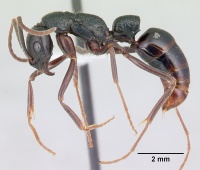Leptogenys lohahela
| Leptogenys lohahela | |
|---|---|

| |
| Scientific classification | |
| Kingdom: | Animalia |
| Phylum: | Arthropoda |
| Class: | Insecta |
| Order: | Hymenoptera |
| Family: | Formicidae |
| Subfamily: | Ponerinae |
| Tribe: | Ponerini |
| Genus: | Leptogenys |
| Species group: | saussurei |
| Species: | L. lohahela |
| Binomial name | |
| Leptogenys lohahela Rakotonirina & Fisher, 2014 | |
Leptogenys lohahela is limited to the rainforest of the PN Andohahela in southern Madagascar. It has been collected from leaf litter sampling and pitfall traps. The species forages on the forest floor and nests in rotting tree stumps.
Identification
A member of the saussurei species group. Rakotonirina and Fisher (2014) - Worker. Mandible short and robust, capable of closing tightly against clypeus; anterior clypeal margin medially projecting into triangular lobe; clypeus with sharp edge or lamella. Eye large, diameter markedly greater than maximum width of antennal scape. Dorsum of head and mesosoma noticeably sculptured; with mesosoma in dorsal view, metanotal groove distinctly visible. In dorsal view, posterior margin of petiolar node straight, not medially excised; in profile posterolateral margin of petiolar node with small, sharp tooth.
Leptogenys lohahela can be confused with Leptogenys saussurei and Leptogenys acutirostris with respect to the presence of metanotal groove, but the latter species are larger in size, the posterior margin of the petiolar node, in dorsal view, is medially emarginated for L. sausurei, and the posterolateral margin of petiolar node, in profile, is with a blunt angle, not a small sharp tooth for L. acutirostris.
Keys including this Species
Distribution
Latitudinal Distribution Pattern
Latitudinal Range: -24.7639° to -24.76666667°.
| North Temperate |
North Subtropical |
Tropical | South Subtropical |
South Temperate |
- Source: AntMaps
Distribution based on Regional Taxon Lists
Malagasy Region: Madagascar (type locality).
Distribution based on AntMaps
Distribution based on AntWeb specimens
Check data from AntWeb
Countries Occupied
| Number of countries occupied by this species based on AntWiki Regional Taxon Lists. In general, fewer countries occupied indicates a narrower range, while more countries indicates a more widespread species. |

|
Estimated Abundance
| Relative abundance based on number of AntMaps records per species (this species within the purple bar). Fewer records (to the left) indicates a less abundant/encountered species while more records (to the right) indicates more abundant/encountered species. |

|
Biology
|
Castes
Nomenclature
The following information is derived from Barry Bolton's Online Catalogue of the Ants of the World.
- lohahela. Leptogenys lohahela Rakotonirina & Fisher, 2014: 121, figs. 1B, 34A, 36A, 139, 146 (w.) MADAGASCAR.
Unless otherwise noted the text for the remainder of this section is reported from the publication that includes the original description.
Description
Worker
(7 specimens). HW: 1.49–1.73, HL: 2.02–2.29, CI: 72–75, SL: 1.98–2.26, SI: 128–137, PW: 1.30–1.42, WL: 3.07–3.38, PNH: 1.13–1.34, PNL: 0.93–1.19, PNW: 0.92–1.06, DNI: 88–108, LNI: 112–122.
Head more or less rectangular, width not increasing from level of eyes to the front, but slightly decreasing behind level of eye toward posterior border of head. Median lobe of clypeus triangular and prominent, without anterior teeth on each side of median carina; lateral margin not interrupted and sharp. Metanotal groove visible with mesosoma viewed dorsally; in profile, mesopleural sulcus indistinct, but upper portion at level of metathoracic spiracle with wide, shallow impression. In dorsal view, petiolar node longer than broad, posterior margin straight and not medially excised. With head in profile, anterolateral portion from level of eye reticulate-rugose; in full-face view, the dorsum with dense punctures which become shallower and more scattered near posterior cephalic margin. Mandible finely striate, interspersed with piligerous punctures. Dorsum of pronotum distinctly with larger and denser punctures compared to the rest of dorsum of mesosoma. In dorsal view, petiolar node covered with smaller and sparser punctures; in profile, upper half of sides of node densely punctate, superimposed with faint rugulae.
Type Material
Holotype worker: Madagascar, Toliara, PN Andohahela, Col de Sedro, 3.8 km 113° ESE Mahamavo, 37.6 km 341° NNW Tolagnaro, -24.7639, 46.7517, 900 m, montane rainforest, ground forager, 21–25 Jan 2002 (Fisher, Griswold Arthropod Team) collection code: BLF05234, specimen code: CASENT0001203 (California Academy of Sciences). Paratypes: 2 workers with same data as holotype but with specimen codes: CASENT0001198, CASENT0247210 (CASC, The Natural History Museum).
References
- Rakotonirina, J.C. & Fisher, B.L. 2014. Revision of the Malagasy ponerine ants of the genus Leptogenys Roger (Hymenoptera: Formicidae). Zootaxa 3836, 1-163.
References based on Global Ant Biodiversity Informatics
- Rakotonirina J. C., and B. L. Fisher. 2014. Revision of the Malagasy ponerine ants of the genus Leptogenys Roger (Hymenoptera: Formicidae). Zootaxa 3836 (1): 001163.


